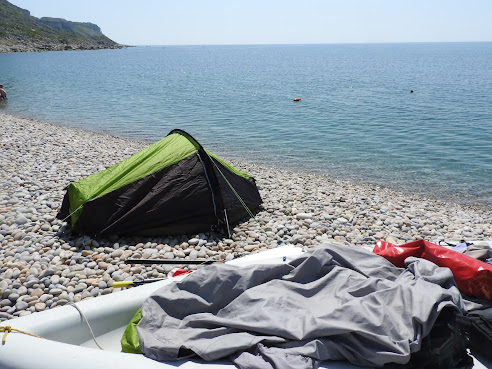For a while I have been wanting to visit Chesil Beach again.
Chesil Beach is the line extending in the middle of the picture, separated from the mainland by water.
This 18 mile pebble beach in Dorset presents a challenge for any form of boat, being a lee shore in the prevailing south westerly winds. In days gone by, hapless ships would be embayed off this shore, driven onto the grinding pebbles of the beach, and destroyed by the crashing waves and undertoe.
So I had to go when there was calm weather, a smooth sea and little wind, preferably blowing offshore.
I started ten miles west along the beach, at Abbotsbury. To access the beach, PicoMicroYacht had to be pushed between a gap in some rocks.
It was then dragged up the back of the beach ready to be slid down to the sea the next morning. The beach is about 11 metres high.
As the sun was rising I started to row eastwards.
On the horizon was the St Catherine's Chapel, built by monks in the 14th Century as part of the Abbotsbury Abbey. I was curious about the name and found on the internet that St Catherine was a persecuted Christian from Alexandria, canonised as a patron saint of philosphers, amongst others. The Abbotsbury monks had venerated her. I discovered she was murdered, her punishment for her faith being tied to a wheel and set alight, the origin of the firework name 'Catherine Wheel.'
I rowed onwards, with mile upon mile of shingle on my right. I have read that some find this monotonous, but I was marvelling at the changing patterns of the shingle bank.
Although isolated and mainly deserted, along the way are boats for sea fishing, reached by ferrying across the stretch of brackish water that separates the bank from the mainland.
My destination was the base of the Isle of Portland the stone island that splits East and West Dorset into different sailing areas.
After about three and a half hours of rhythmic rowing in calm waters I was at Chesil Cove, nestling under the island.
Beaching PicoMicroYacht in the very calm sea was still not straightforward due to the steepness of the bank. Eventually I was able to drag PicoMicroYacht above the tideline and erect a small tent for shelter.
That night I sensed moonlight from inside the tent and looked out to see the moon rising over Portland Island.
The next morning the wind had got up, blowing offshore. I put the PicoMicroYacht masts up and fitted a new bowsprit I made recently.
PicoMicroYacht was slid out into the sea. As I readied the boat for sailing back to Abbotsbury, I was quickly blown out to sea and the waves began to make their presence.
The extent of the wind meant I did not need to row, so I got PicoMicroYacht under control and used the sails to slowly angle back to the shore where it would be calmer.
I skirted along the beach. Again, it was relatively deserted, but I did spot a solitory walker. I know from accounts of walking the beach it is heavy going along the shingle, and I was having a much easier time of it.
The Isle of Portland was now several miles away.
The odd fisherman was to be avoided, their lines extending well out to sea.
Onwards I went, the beach stretching into the distance.
Eventually, the presence of beach people indicated I was now back at Abbotbury.
On arriving, a family came and helped PicoMicroYacht up the beach, instructed by the father. Feeling fatigued ,I thanked them profusely.
When they finished, the father touched elbows and spontaneously said: 'God Bless you Brother.' It seems strange to write this, but being blessed by a stranger was a positive for me.
All I had to do now was slide PicoMicoYacht back down the other side of the beach and I had finished my adventure.

















































